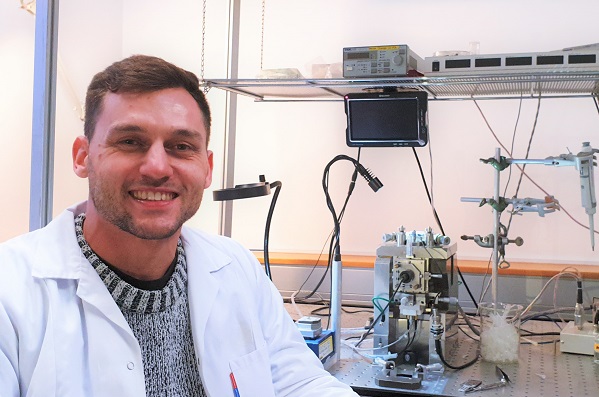Advanced microscopy methods focus on the nanometer range (1 nm = 1 millionth of a millimeter). As a comparison, a virus is between 30 and 50 nanometers in size.

No other instrument has advanced science as much as the microscope. Starting in the early 17th century to the present day, advancement in this field have led to pioneering microscopy methods operating in the nanometer range (1 nm = 1 millionth of a millimeter). As a comparison, a virus is between 30 and 50 nanometers in size.
When it comes to this size, there are two issues at the forefront, namely delivering applicable images and second, making sure samples in the nanometer range are viable as they can be easily altered or damaged. Microscopy methods must, of course, be able to rule this out. Scientists at the JKU’s Institute of Applied Experimental Biophysics (dept. head: Prof. Peter Hinterdorfer) are working on materializing images that have a spatial resolution under 1 nm in order to study biological materials under living environmental conditions.
In the Spirit of a Nobel Laureate
Named after the famous Nobel Prize winner, the Marie-Skłodowska-Curie program was launched the EU and the state of Upper Austria to fund and finance outstanding research. The program aims to establish a pool of European researchers and attract more top scientists and academics to Europe. Researchers are free to choose their subject area and topic. The program’s most important feature is mobility. Participants are expected to spend a longer period abroad and thereby deepen their expertise, hone their skills, exchange information, and make valuable research connections.
PhD candidate Daniel Canena (Universidade Federal do Rio de Janeiro) came to the JKU as part of this program. Together with JKU researchers, the Brazilian scientist developed a high-speed scanning probe microscope to track molecules that can integrate high-speed imaging using single molecule detection capabilities. This new microscope is based on the topography and recognition method (TREC) originally developed by the JKU team using a suitably modified high-speed module and can now measure hundreds of times faster with a spatial resolution of less than 1 nm.
The 31-year-old Brazilian researcher added: "My stay here at the JKU has been a unique experience. The work conducted here demonstrates an impressive level of professionalism."
New Generation of Microscopy
Scanning probe microscopes have overcome fundamental barriers. New systems exhibit unprecedented potential in terms of nanoscale 3D imaging capabilities, imaging speed, and chemical sensitivity mapping. The European Training Network SPM2.0 (coordinated by the Institute of Bioengineering Catalonia) aims to train a new generation of researchers in science and technology to use these trailblazing methods of scanning probe microscopy to drive advancements, rapid and broad commercialization, and the implementation in public and private research centers as well as at industrial and metrology institutions.
Prof. Hinterdorfer explained: "Ultimately, the network’s goal is to establish Europe as a world leader in scanning probe microscopy technologies and expand the new applications into key sectors, such as materials, microelectronics, biology and medicine. The Marie Curie funding program contributes significantly to this objective."
JKU Rector Meinhard Lukas explains: "Research is no longer a “one-man show”. Science is based on networked expertise in various disciplines and here at the JKU, it’s a principle we wholly uphold and support. Our scientists are shaping technological advances in an interdisciplinary and international way. The Marie Curie funding program shows just how important this topic is to the country and in the EU. I am impressed at the way everyone is pulling together and enabling JKU to be an effective part of innovative research, something that extends far beyond Austria’s borders."
The Marie Curie Funding Program Makes International Networking Available to the JKU and Its Students
Markus Achleitner, Minister of Economics and Research, remarked: "Science, research, and technological advancement require networking, information exchange, and discourse in order to stimulate and inspire new ideas and approaches. This is how we conduct top, high-quality research and this idea is what’s at the heart of the Marie Curie funding program, which is supported by both the state of Upper Austria and the European Union. It isn’t about the research topic per se; the decisive criterion to get the grant is more about enabling top researchers to go abroad. The latest Marie Curie Fellow, Daniel Canena, is a very impressive example of just how science and research intertwine. The Brazilian scientist from the Universidade Federal do Rio de Janeiro conducted research on a new microscopy method with a team of researchers at the Johannes Kepler University. This research is part of an educational network coordinated in Catalonia intended to make Europe a leader in high-speed scanning probe microscopy."
Parliament member Achleiter added: "The funding program is not only an opportunity to attract young, international researchers to Upper Austria, but it also gives Upper Austrian students a unique opportunity to access international research networks during their studies. At the same time, the program raises Upper Austria’s visibility as a location of science and research."








